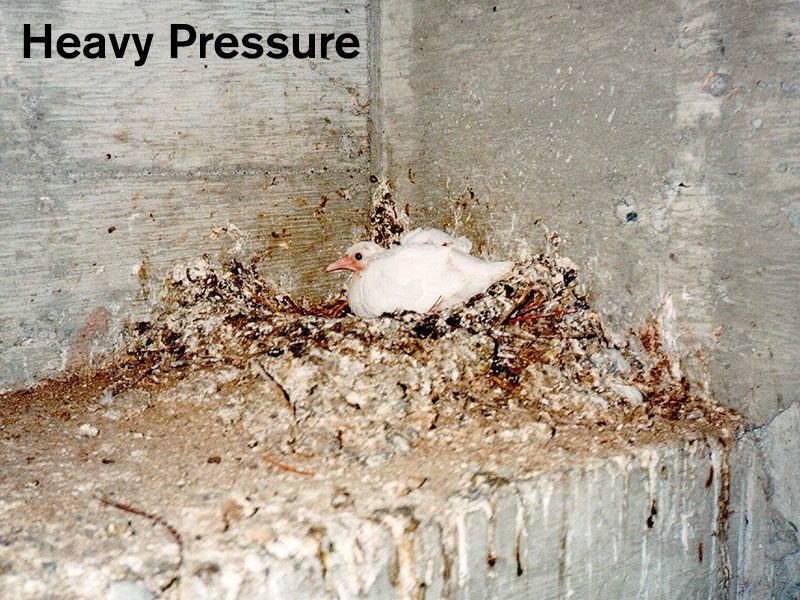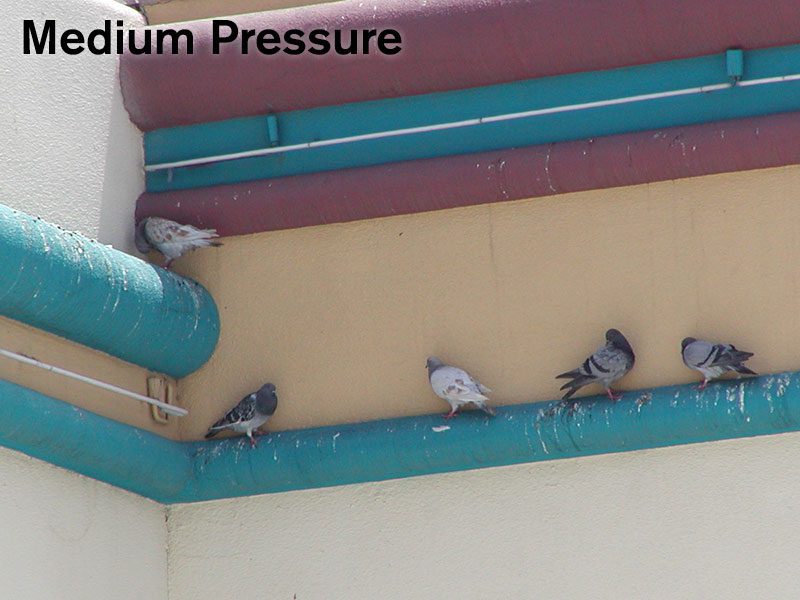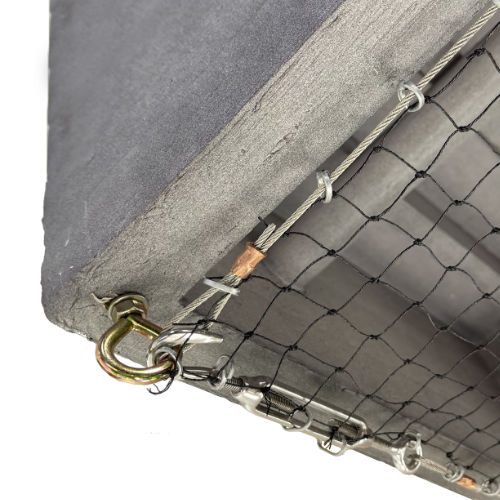Bird Pressure
What attracts birds to one building and not another? What is the best solution for moving the birds off a site? What causes a bird product to fail? Knowing the answers to these questions requires a solid understanding of bird behavior and habits. It is this knowledge that will determine the profitability and success of your bird control jobs.
Your success in moving birds from a particular site depends on selecting the right products to overwhelm the bird’s determination to return to the site. How hard the birds fight to regain their former territory is what we call “Bird Pressure.” It is important to understand that bird pressure can vary over different parts of a building or job site as described below. For example, recessed nooks and crannies where birds are nesting will have higher bird pressure than the flat part of a roof.



Heavy Bird Pressure
Birds are very committed to a high pressure site. Chances are they were born on this specific ledge, usually a protected overnight roost and may have raised their own young in the same place, thus they consider this area home. They react to products there much like you would if you found plywood nailed over your door; you’d be determined to get past it. Heavy pressure sites always provide the birds shelter from the elements.
Medium Bird Pressure
Birds are a little less committed to medium pressure sites. This is more likely an area where they observe food opportunities or rest in the afternoon there for many different reasons. They’re fairly committed to the site, but they don’t roost or nest there.
Light Bird Pressure
Like a bench you occasionally sit on in your neighborhood park, light pressure sites are take-it-or-leave-it sites for pest birds. They may stop by after a meal to take in the warmth of the afternoon sun, like the parapet around an office building. The absence of food and shelter makes it a casual daytime loafing spot.
Three main points to bird behavior provide the foundation for understanding bird pressure. Pigeons, starlings, crows, house sparrows and gulls all share these behavioral traits.
- These birds are flocking (children will stay with parents) and non-migratory (they are not going anywhere)
- Their numbers are determined by available food (open dumpsters, friendly bird lovers, food processing plants, etc.) and shelter (enclosed ledges, trees, vents, etc.)
- Established, resident birds will fight harder than newcomers to reclaim a site. For example, if you went home tonight and there was a different lock on the door, you would battle your way into the house. This effect is magnified for nesting birds with young (same example, plus you left your kids in the house).
From these three behavioral traits, we can accurately determine the level of bird pressure by measuring the following six scales:
1) Food Source
Look for two things when examining the site: amount of food/water and controllability. Birds will fight to return to a spot where there is food available. Areas with limited food that can be removed or contained are low pressure areas, while a site with large amounts of permanently available food is high pressure. An example of a low food target area would be a typical suburban home, while a granary or food processing mill would be high.
2) Building Attractiveness
Birds like protected areas out of the elements to nest, loaf or overlook feeding areas. The more the building provides these protective elements, the more attracted birds will be to the site. When examining the site, measure the number and quality of potential nesting and landing sites along with proximity to food and water sources.
3) Alternative Sites
Are there other attractive, available sites where the birds can move after excluding them from the job site? If the birds do not have other nearby places to go, they will fight harder to return to their old home.
4) Resident Flocks
Estimate the number of birds at the site. What are they doing at the site? Loafing birds are the easiest to move, while evening roosting birds are much more difficult and nesting birds are the most difficult.
5) Other Flocks
Are there other flocks of birds in the area? This measurement is particularly relevant only when using dispersal techniques such as Avitrol. Dispersal techniques move the current resident flock, but other birds will quickly move in to fill the vacancy. Furthermore, if there are large numbers of other birds in the area, the displaced birds will have a tougher time finding a new place and will fight harder to return to the job site if other nearby areas are already occupied.
6) Overall Pressure
Look at how you graded each scale to determine overall pressure at the site. Keep in mind that the bird pressure may vary over different parts of the building site. Lower level ledges next to the food court on a mall building will have higher pressure than a window sill on the far side of the mall. After determining the pressure at a site, use the product technical sheets to select which products to use.


